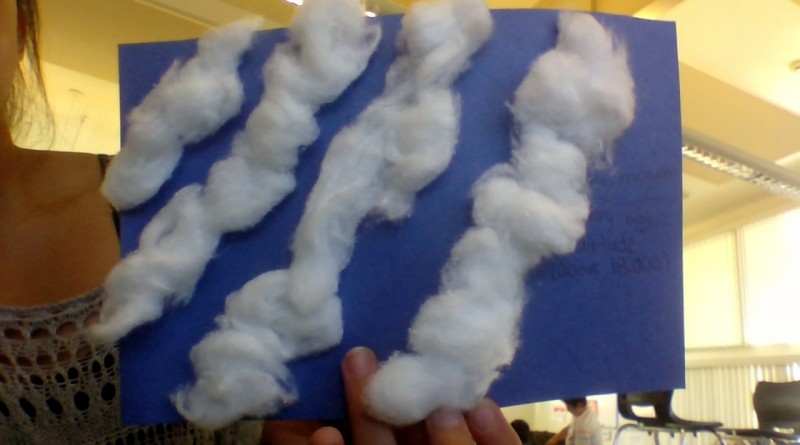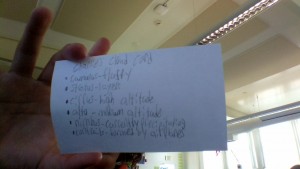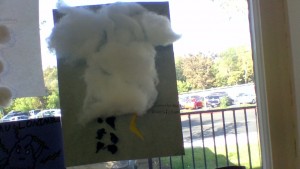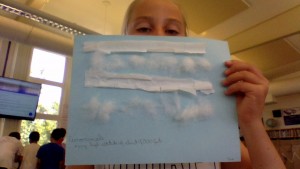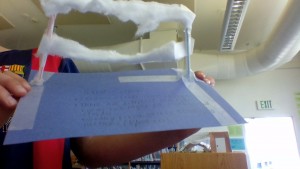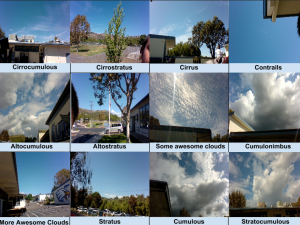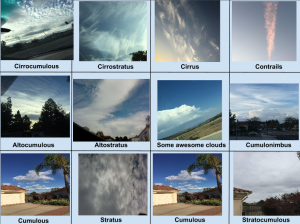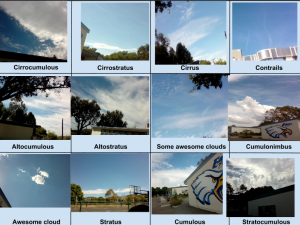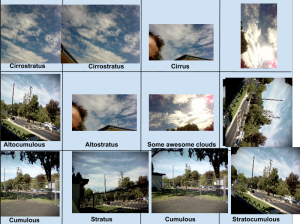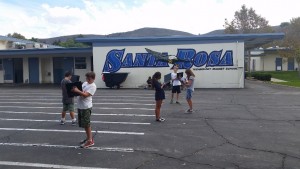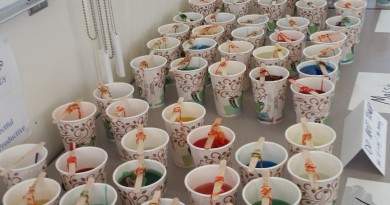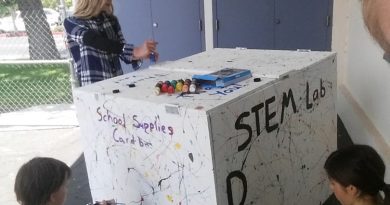Clouds
Objective:
Students will be able to explain how changes in temperature, pressure, and humidity lead to cloud formation
NGSS Standards:
MS-ESS2-5 Collect data to provide evidence for how the motions and complex interactions of air masses results in changes in weather conditions. [Clarification Statement: Emphasis is on how air masses flow from regions of high pressure to low pressure, causing weather (defined by temperature, pressure, humidity, precipitation, and wind) at a fixed location to change over time, and how sudden changes in weather can result when different air masses collide. Emphasis is on how weather can be predicted within probabilistic ranges. Examples of data can be provided to students (such as weather maps, diagrams, and visualizations) or obtained through laboratory experiments (such as with condensation).] [Assessment Boundary: Assessment does not include recalling the names of cloud types or weather symbols used on weather maps or the reported diagrams from weather stations.]
Overview of Lesson:
In writing the objective for this lesson, the topic of clouds is really going to only be a DOK 1 or 2 activity. Understanding cloud formation does tie in several previous lessons on convection currents and humidity, but the final objective unfortunately doesn’t go much deeper for 6th grade. The first activity on clouds was What is a Cloud? which introduced the students to humidity and saturation. Students did a quick experiment with adding water to a dry sponge and a wet sponge to observe that the wet one will quickly precipitate and the dry one can hold a lot more water. I used a pink sponge and a yellow sponge for this activity, leading to the sponges being named Spongebob and Patrick and increasing the student interest in the activity significantly. To observe dew point, I tried to get a water bottle with ice to show them condensation but if I couldn’t find one then students could relate to this one fairly well. The final crowning part of this activity was connecting rising convection currents and condensation into cloud formation. I have a few videos to help demonstrate this and a wonderful Tom Glazer song that I used to sing as a class.
The cloud formation assignment above directly connects to the NGSS standard and helps further their understanding of motions in the atmosphere. While for the most part I have extricated the CA State Standards from my teaching, one topic I haven’t brought myself to let go of is the identification of different types of clouds. I don’t ask students to memorize them for a test, but I do feel that as a citizen of Earth, there’s a lot to be learned from looking at the clouds. My next assignment called Clouds!! had information about all the different types of clouds and photos of the clouds, many of which have been taken by me on family vacations. In previous years, I had all the students create cotton ball models as a whole class activity as I went through the presentation. For this self-directed activity, students viewed the presentation at their own pace and then at the end created their own model of one cloud and made their cloud identification card. The card is an organized list of the names and prefixes for clouds to help them identify clouds.
The final activity became an ungraded add-on called Cloud Bingo. I challenged the students to find examples of all the types of clouds and to take pictures of them. This did force them to apply their lesson to the real world and to really think about how hard it is for scientists to classify things they observe.
Areas that students needed help on:
Students who have lived most of their life in Southern California had a lot of difficulty understanding humidity. Even with examples of being in a steamy shower, it’s really hard to get this concept to click for them. The best you can do is hope that the weather will cooperate during this unit so that they can make the actual connection.
Even though we just did several activities on convection currents, there’s still a decent sized group of students who had a lot of trouble thinking back to convection currents and connecting them to cloud formation. This is the question that students needed the most help on and that I sent back to the students the most amount of times to redo. A sampling of student responses:
- Exceeds: Convection currents relate to cloud formation because air gets colder as you go farther up in the troposphere and warm air rises, carrying water vapor with it. When the air temperature in the atmosphere reaches the dew point, the water condenses, forming CLOUDS!
- Proficient: Convection currents relate to cloud formation because warm air rises and the water vapor in the air condenses.
- Partial: When a convection current hits warm land or water, it bounces back and returns up to the sky. As it is now moist, the collision results in the formation of a cloud.
- Partial: Hot air rises high into the sky. Cold air goes lower, condenses, and forms clouds.
- Partial: The moisture heats up at the ground goes up to the atmosphere, cools down into clouds and it rains and repeats the process.
- Below: It relates because they both have something to do with water.
- Below: It pushes them around and that is how the clouds form.
Assessment/Scoring:
What is a Cloud was scored based on the understanding shown in the survey questions. The final question explaining how clouds are formed was half of the overall score.
Clouds!! was scored for completion and following directions.
Cloud Bingo received feedback for errors but never had an official recorded score.
Student samples:
Cloud Card and Cloud Diagrams
Cloud Bingo (click to see larger)
Conclusions/Reflections for the Future:
Studying and finding clouds is an activity that the students really enjoyed, but that I need to figure out if I can continue to justify in the future. Students would rush past the tough explanation part to get to the taking photos part without having a real understanding of clouds. In the future, building the cloud model is not necessary and ended up being a waste of cotton balls. I’d like to think of some way that they could use their observations of the clouds to explain the weather (i.e. cold front is coming, etc.). This assignment is also completely dependent on the weather and blackout bingo may not be possible during the season of instruction. One other major challenge was that the students were completing this using Chromebooks that do not have front facing cameras. Therefore, it was quite a challenge for them to take photos of the clouds for this assignment.
I also am still trying to figure out a way for students to know what to do when working through a presentation on their own. I wanted them to go through a few slides and complete questions on a Google Form but some students couldn’t find the survey etc. This time I had the survey available when you clicked on the arrows, which was not clear to them. I need to establish a consistent format on all of my presentations so that the links they need are clearly visible.
